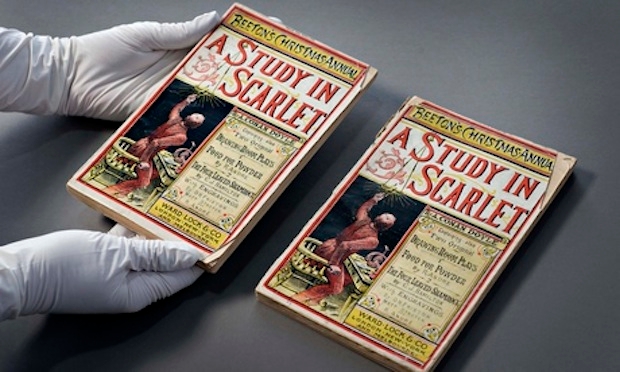Have you ever experienced the joys of Jawohl, meine Herr’n? If not I strongly advise an appointment with YouTube. The song features in the 1954 film Der Mann, der Sherlock Holmes war (‘The Man who was Sherlock Holmes’), and is performed by Hans Albers and Heinz Ruhmann, mainly while soaping themselves in the bath (one each – it’s not that kind of film). Albers and Ruhmann do not, as you might expect, play Sherlock Holmes and Dr Watson, but rather men pretending to be Holmes and Watson in order to solve a crime. At one point they’re prosecuted for the impersonation, with Sir Arthur Conan Doyle (an actor, not the real one) appearing in court to claim the characters as his own. All in all it’s the perfect example of just how far a literary creation can travel from his original form, in terms both of geography and lunacy.
A poster for the film features in Sherlock Holmes: The Man Who Never Lived and Will Never Die, an exhibition that’s just opened at the Museum of London. The detective’s many incarnations are brilliantly captured. Cumberbitches will salivate at the coat Benedict wore in the recent TV version, while traditionalists can enjoy the original drawings by Sidney Paget, the first man to illustrate Holmes for The Strand magazine. It was Paget who decorated the famously powerful bonce with a deerstalker, a hat that isn’t mentioned in any of the stories. Conan Doyle was supremely relaxed about his hero being changed and twisted and re-interpreted. As early as 1899 the American dramatist William Gillette wrote to ask if he could provide Holmes with a wife in a play he was writing. ‘You may marry him, murder him, or do what you like to him,’ replied the author. Of course Conan Doyle took the second of those options himself, only to be forced by public outrage into bringing the detective back to life.
Holmes couldn’t have wished for a more fitting home than this particular museum. ‘It is a hobby of mine,’ he says in The Red-Headed League, ‘to have an exact knowledge of London.’ Victorian maps of the city cleverly display the routes he takes in various cases, while Conan Doyle’s notes reveal the address was originally going to be 221b Upper Baker Street. It’s astonishing that in none of the novels or short stories does Holmes ever visit Soho, the den of intrigue and vice you’d think would have been crying out for his services.
The exhibition brings to life not just Holmes but the Victorian world he inhabited. There’s a 19th century syringe (though not the cocaine Sherlock took with it), a collapsible top hat, and (inspired by a passage in The Sign of Four) a pocket watch displayed under a magnifying glass to show the marks left by a repairer. I didn’t notice any reference to one of my favourite facts – Watson’s war wound moving around his body in different stories – but there’s so much on display that I may just have missed it. That would have been to commit the ultimate Holmesian sin: ‘You see, but you do not observe.’
You have until next April to proceed to the museum and make your own deductions.






Comments